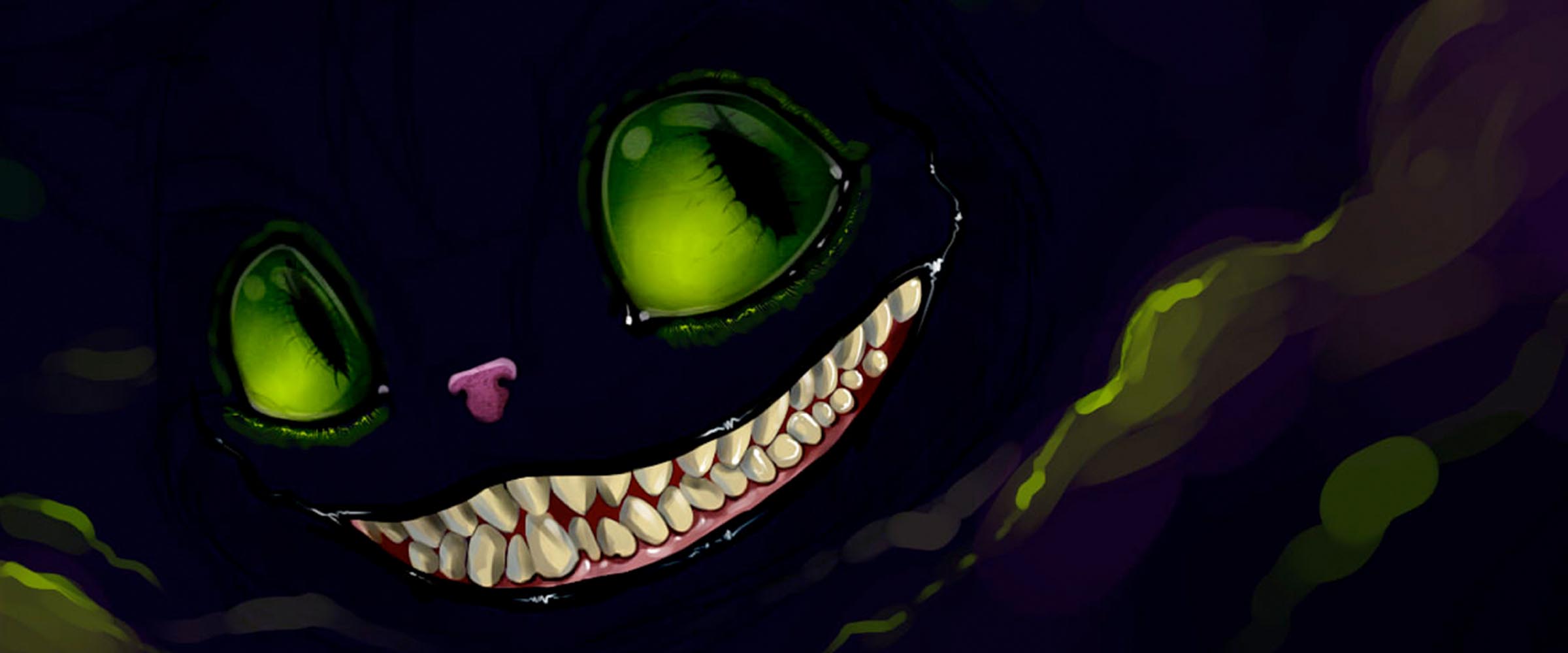
What if the Cheshire Cat Were Real?

Vexing Riddles & Mannerisms
Alice: Would you tell me, please, which way I ought to go from here?
The Cheshire Cat: That depends a good deal on where you want to get to.
Alice: I don’t much care where.
The Cheshire Cat: Then it doesn’t much matter which way you go.
Alice: …So long as I get somewhere.
The Cheshire Cat: Oh, you’re sure to do that, if only you walk long enough.
The Cheshire cat speaks in riddles, making him nearly unintelligible despite the fact that he can speak. There are two possibilities that need to be investigated:
1. You’re being hypnotized or mad as a hatter.
2. There are developmental reasons why the cat can’t say much of use.
Possibility 1: Hypnotization.
After some searching it would appear that Sarah Hartwell is the Internet’s foremost cat expert, and most of what I’m about to say is straight from her thorough research.
There have been suggestions that cats can call birds to them by chattering their teeth, inducing a form of hypnosis through the high-frequency jitter. It’s possible that this sound could make prey–which would normally avoid the cat–overcome caution for curiosity.
There are a great many curious things in Wonderland, and the Cheshire cat appears to have a tremendously large set of teeth. It might be reasonable to conclude that the purpose of his large set of fangs is solely to hypnotize and induce drug-like hallucinatory effects, which could explain a lot of what occurs in Alice in Wonderland (and despite rumours to the contrary, Lewis Carroll was not on drugs when he recorded the events).
Unfortunately there are few other easy ways to prove whether or not Alice was hallucinating during or after her encounter with the Cheshire Cat, so we shall just have to accept the possibility of madness or hallucination and keep tumbling down the rabbit hole.
Possibility 2: Cat Development.
It’s been said that dogs speak only in consonants, whereas cats make use of vowels (or vice versa, depending on who you ask). In fact, the extent to which cats seem to be able to give more nuance to their utterances prompted Alphonse Leon Grimaldi, in 1895, to declare the discovery of cat language. He made reference to 63 different notes, while others made different categorizations to try and better understand their feline companions. Some have declared there to be 19 different meows. Despite the lack of agreement there seems to be a common theme that cats have much richer inner lives than they might otherwise let on. Some have suggested that were the speech of cats studied as rigorously as birdsong, we would recognize the depth to which it really goes.
Theories abound, but little remains proven. There is anecdotal evidence that numerous cats have been reported speaking to their owners in either Turkish, Mandarin or Cantonese, but unfortunately there is a strong correlation between the number of these claims and the number of crazy cat persons.
What has been observed, however, is that cats get positive feedback from sounds. They learn that a certain sound can invoke a given behaviour in their owner, and so development continues in this vein, progressing from simple tonal indications of pleasure or displeasure, all the way to near-conversation. That’s right–cats can mimic patterns of noise and pauses, so that if you were to muffle the sound, the overall impression would be that of two people talking. And this ability seems to get better with age.
Even if the Cheshire Cat weren’t speaking originally in English, it’s possible that he has a cat-speech interpreting device that tries to make sense of his larynx output. And if he had learned to mimic conversation by tonal patterns and pauses, it’s very possible that the speechbot’s output would be exactly what was observed…
Invisibility
Bending light completely around an object is no longer the realm of fiction. Metamaterials research is an intensely interesting field of research right now, and the concept of cloaking is pretty simple. We can see things because of light scattering off them. Metamaterials suppress this scatter, and bend the light in such a way as though nothing were ever there in the first place.
How is this done? The advance of nanotechnology has allowed us to create patterns on such a small scale that we really can fine-tune how all of the normally scattered waves combine. We can make them cancel out, add up, in almost anyway imaginable because of the degree to which we can now control structure. One of the major hurdles, however, is the fact that this process is colour-sensitive, so that a material can be designed to perfectly cloak one colour. However, that means we can still see it in the rest of the visible spectrum. The road toward a perfect cloak will require a lot of work getting metamaterials that work for a broad spectrum of colours, and that’ll take a lot of computing. We might have time for a few catnaps between now and then, unless we can snatch the Cheshire Cat and figure out his secret.
Perpetual, huge smile
The cats of Cheshire England could potentially have a genetic adaptation in their jaws for hypnotizing their prey, in which case the large set of teeth makes sense, and we probably have long ago stopped making sense to those around us. Another possibility, however, is the fact that the Cheshire Cat has to have a way to observe the world around him, while still perhaps remaining cloaked. That means that he must have a way of selectively letting light pass through an aperture in his metamaterial cloak.
To maximize his field of view from a small aperture, a fisheye lens could be the cat’s best bet (although he might be sorely disappointed it tastes nothing like the real organism). You might already be familiar with some of the distortion effects a fisheye lens has on an object. Now if I were to apply this effect on our cat, and suggest that perhaps the lens is a trifle wider than it is tall to account for the cat’s binocular vision, we get the following result:
Fur Colour
Apparently a cat’s fur can change colour based on temperature, sun, nutrition, and age. It is hard to imagine how such a vivid colour could be created through these factors alone, and let us assume that the Cheshire Cat’s owner is not drinking the Kool-Aid, or rather, not pouring it on his poor pussycat.
Another explanation, more in line with the above arguments, is that the metamaterial cloak the Cheshire Cat uses is imperfect, and less effective for shorter wavelengths (i.e. blue and purple!). All the colours of the rainbow go gliding on by, except the famously bright hues shown above.
It’s clear the Cheshire Cat has achieved complete invisibility, even if he selectively chooses to leave his fisheye lens aperture open to interact with the world. Therefore, a further explanation is that he has a secondary device which he switches on or off, working primarily on his signature blues and purples. The primary metamaterial cloak he keeps on all the time, rendering him mostly invisible if only us pesky humans couldn’t see purple.
The Verdict
The Cheshire Cat could be a normal cat, with the following devices:
1. A cat-speech interpreter that reflects the limits of cat language mimicry.
2. A primary metamaterial invisibility cloak that doesn’t work so well on shorter wavelengths (blues and purples).
3. A secondary, switch-activated cloak that renders him completely invisible; and
4. An apertured fisheye lens near his mouth that distorts his teeth in such a way as to make his grin appear larger than it really is.
In short, the Cheshire Cat is real, and he’s out there. Right now.
Be sure to check back next week for the next “What if” segment. Have suggestions for the next article? Post them in the comments or e-mail hal.friesen@gmail.com.

!["You must be [mad], or you wouldn't have come here."](http://halfriesen.com/wp-content/uploads/2013/03/The-real-Cheshire-Cat-the-cheshire-cat-25098658-500-500-300x300.jpg)





